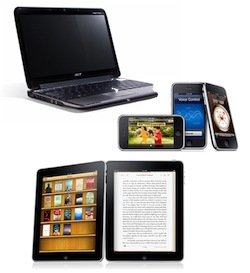Is print journalism dead? I got the question overnight in email from a student working on a research paper. He’d seen this post on this blog about that. He asked me to answer these three questions. So these are his questions with my answers.

1.) What are the factors that have led to falling sales?
Start with cost: Print media have the cost of paper and the cost of physical distribution. Online media don’t. Is the print version worth the difference to the customer? To the advertiser? For now, sometimes yes, and sometimes no. Over the long term the increased acceptance of digital media makes the cost difference more important.
Add convenience: I believe digital is inherently more convenient. My iPad, my Kindle, and my iPhone are more convenient because I have all the media in one small package. That’s also true for a lot of droid users. That’s not true for everybody, of course. Some people prefer paper. I know that. But I believe the relative convenience of digital will win over time. That’s my opinion.
2.) How can newspapers in particular re-position themselves in the digital media market to halt the decline in circulation?
Newspapers need to be available on the major operating systems of phones and tablets.
Enhance the value for readers and advertisers. Add search and social media and comments and links to take advantage of digital in ways that printed newspapers can’t.
Do the reporting that citizen journalists and opinion-based bloggers and social media don’t. Do the investigative reporting. Cover the town hall and local issues. Stay objective, reliably, and trustworthy.
3.) Is the trend terminal and, if so, does it matter?
No, of course it’s not terminal. Nothing is ever absolute. Some newspapers and magazines will survive for a long time. The long tail will be there. But over time the survivors will be fewer, more narrow, and less important.
So that’s my opinion.
And I don’t consider myself an authority on this. I’m not a researcher. Look at the thorough research being done by the major Journalism grad schools (Columbia, University of Missouri, University of Oregon, Stanford, many others) for a lot more info.
But I do have an opinion; and it is informed by nine years as a mainstream Journalist, 30 years as a magazine columnist on occasion, and seven years as a professional blogger. And I’ve got a master’s degree in Journalism. And I enjoy sharing opinions. For more on that, check out the Journalism category on this blog.

 Make the wrong choice and you end up like my polar bear friend here to the left (with apologies for changing the simile abruptly from continental drift to ice sheets breaking up, but it does sort of show it, doesn’t it?) You’re on a shrinking platform. Of course the polar bear can swim long distances. Users can jump platforms, but it costs time and money. Developers and manufacturers can jump platforms too, but it costs more time, and more money.
Make the wrong choice and you end up like my polar bear friend here to the left (with apologies for changing the simile abruptly from continental drift to ice sheets breaking up, but it does sort of show it, doesn’t it?) You’re on a shrinking platform. Of course the polar bear can swim long distances. Users can jump platforms, but it costs time and money. Developers and manufacturers can jump platforms too, but it costs more time, and more money. Most of you have grown up assuming cell phones, transportable video, and computers are everywhere. Can you imagine that when I was growing up we had three channels on the television, in black and white? We were already in our thirties before we had videotapes so we could watch movies at home. To see a specific TV show we had to plan our evenings and be ready at the television when it started. And we all watched the commercials together.
Most of you have grown up assuming cell phones, transportable video, and computers are everywhere. Can you imagine that when I was growing up we had three channels on the television, in black and white? We were already in our thirties before we had videotapes so we could watch movies at home. To see a specific TV show we had to plan our evenings and be ready at the television when it started. And we all watched the commercials together.
You must be logged in to post a comment.